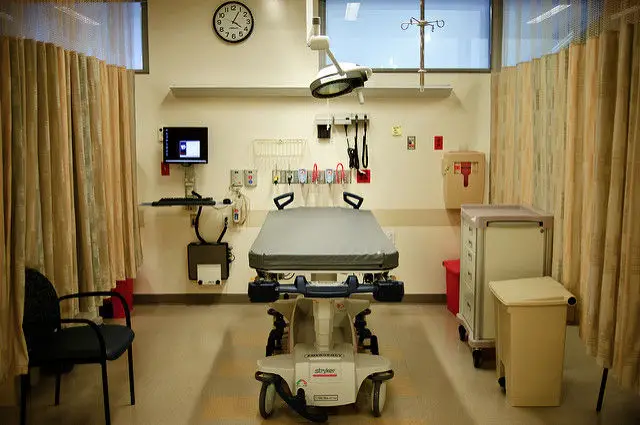The IW NHS Trust responds to news released this morning in relation to pressure on NHS beds during the winter period.
NB: St Mary’s Hospital and IW Health and Care system were de-escalated from Black to Red on Thursday. This in from the IW NHS Trust. Ed
Bed occupancy and the Nuffield Trust winter insight briefing
Commenting on the briefing paper from the Nuffield Trust, Isle of Wight NHS Trust Chief Executive Officer Karen Baker said:
“At times we struggle with an imbalance in admissions and discharges. It only takes a few patients one way or the other to tip us into difficulties. Unlike the mainland, as a small Island we are unable to rely on the support of neighbouring hospitals or care facilities in neighbouring counties. We cope by opening additional capacity but that can be at the expense of patients waiting for surgery.
“We are well aware of the risks involved in operating at such a high capacity and do what we can to mitigate against the risks, including bringing in extra staff. Despite the pressures we are facing the Trust has a good record on infection control with zero MRSA cases and only four cases of C. Difficile (below the national target) this year.
“Our work with partner agencies recognises that we cannot continue providing services in the same way because of the pressures in the health and care system. Our new model of care will see more patients treated in their own homes or closer to home and fewer admissions to hospital. This week, due to the pressures we are experiencing, we have implemented an expanded 24/7 fast diagnosis, treatment and discharge to home service.”
England’s only fully integrated NHS provider
As the only fully integrated NHS provider of ambulance, community, hospital, learning disability and mental health services in England the Trust manages St. Mary’s Hospital, the only acute hospital facility on the Isle of Wight with 252 beds.
The Ambulatory Emergency Care service at St. Mary’s Hospital provides fast diagnosis, treatment and discharge to home for those patients who do not need admission to hospital – whose condition can be managed in the community. The principles are explained in a video created by the NHS Institute for Innovation and Improvement.
https://youtu.be/j9zV-WbRFQU
The new care model for the Island is being developed as part of the My Life a Full Life partnership.
This following press release comes from the Nuffield Trust. Ed
Pressure on NHS beds could risk patient safety think tank warns
Pressure on beds in the NHS in England has become so acute that on any given day last winter, the equivalent of more than five extra hospitals’-worth of beds had to be brought into service to cope with surges in demand. On the single busiest day last winter, an extra 4,390 beds had to be opened, equivalent to more than seven extra hospitals in one day.
And on average, over 95% of beds across English hospitals were occupied every day last winter, despite evidence that once bed occupancy rates exceed 85%-90%, there is an increasing risk of infection. Given that pressures on the health service have not lessened over the last 12 months, Trusts will face similarly high bed occupancy rates this winter.
These are the findings of a new analysis by the Nuffield Trust health think tank, the first of a new short series of briefings from the Trust examining the extra pressures on the NHS in winter.
High bed occupancy rates a problem
Last week NHS England published the first of its weekly statistical bulletins for the current winter, with the second week’s figures expected later today.
The report explains that high bed occupancy rates are a real problem for both patients and staff in the NHS:
- Firstly, as occupancy levels rise, it gets harder and harder to find beds for emergency patients who need to be admitted from A&E – affecting a hospital’s ability to meet the standard that 95% of patients attending A&E should be treated, admitted or discharged within four hours.
- Secondly, high rates of occupancy lead to problems in maintaining cleanliness and infection control.
- Thirdly, high levels of bed use can make patients’ experience of hospital unpleasant and disruptive, as patients are moved around to accommodate others, or placed on inappropriate wards (elderly patients on obstetrics wards, for example) when there are no free beds on the right ward for them.
- Finally, hospitals need some slack in the system to be able to deal quickly and efficiently with outbreaks such as flu and norovirus, where numbers affected can rise very quickly.
Findings of the report
The report finds that:
- The average number of extra beds brought into service on any given day last winter was 3,466, equivalent to at least five and half extra hospitals’-worth of beds.
- On the single busiest day last winter, Tuesday 26th January 2016, the number of extra beds hospitals had to make available to accommodate patients reached its highest level, when 4,390 extra beds were opened – equivalent to bringing onstream an extra seven entire hospitals on that one day.
- The previous day, Monday 25th January, one in seven Trusts reported that all their acute beds were full, and nearly four out of 10 had bed occupancy levels of over 98%. This was after opening nearly 4,200 extra beds that day.
- Throughout that week, nine Trusts (see note 6) were all full every day with 100% of their acute beds – including extra escalation beds brought in temporarily – occupied.
- The following Monday, 1st February, 72% of all Trusts recorded bed occupancy levels exceeding 95%.
- On average across the whole of last winter, around 95% of the almost 100,000 available beds in England were occupied, even with all the extra escalation beds pressed into service.
The research
The research analyses bed availability and occupancy numbers for each Trust from the daily situation reports (‘sit reps’) NHS England published last winter, as they have each winter since 2010/11. These sit reps cover every weekday from Monday to Thursday during the period 1st December to the last day of February, with a combined figure for the period from Friday to Sunday each week.
The data provides figures for the number of core beds available each day (the number of beds a Trust has available under normal circumstances), the number of escalation beds available (the additional beds each Trust has to bring into service to cope with extra patients), and the number of beds occupied by patients. From these figures, we calculated the proportion of total occupied beds (the ‘bed occupancy rate’) each day last winter at each Trust, and the average for England as a whole on each day.
Commenting on the findings, Prof Appleby said:
“Our analysis shows just how acute the pressure on beds was last winter, with around 95% of the beds in all hospitals in England occupied every day. With such high levels of bed occupancy linked to higher infection rates and longer waits in A&E, these pressures pose a real threat to the smooth running of hospitals and, ultimately, to patient safety.
“What’s more, the NHS is going into this winter in an even worse position than it was a year ago, with record deficits, worse performance against the A&E target, far more trolley waits, record delayed discharges from hospital, and fewer people getting the help they need with social care. When you add into that mix the sort of intense pressure on beds we’ve demonstrated hospitals experienced last winter, patients’ care is bound to suffer.”





